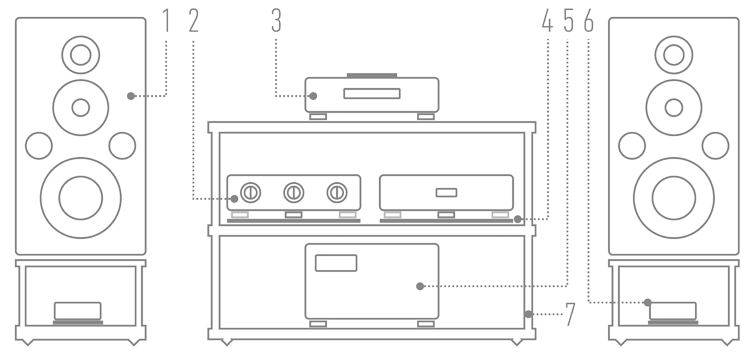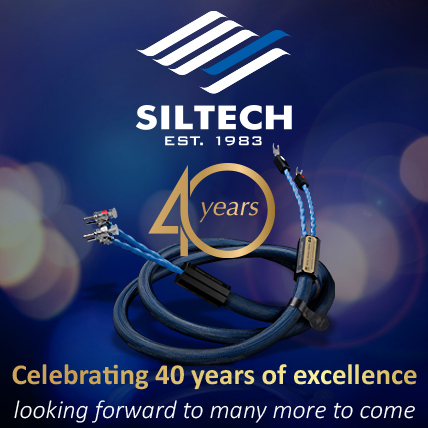|
LOUDSPEAKERS ⸜ floor-standing Avatar Audio
Manufacturer: AVATAR AUDIO |

|
Review
text WOJCIECH PACUŁA |
|
No 257 October 1, 2025 |
|
˻ PREMIERE ˼ ⌈ AVATAR AUDIO – a company run by CZARIUSZ ANDREJCZUK, whose core lineup consists of loudspeakers. Their design differs from contemporary solutions, although – from a technical point of view – there is nothing unusual about them. They are based on ideas from the 1950s, 1960s, and 1970s, and taken to the extreme. We are testing its top model, number 1. This is its PREMIERE. ⌋ I'S BEEN FIFTEEN YEARS since I started working on speakers – finally, you'll hear my most expensive and best design”, – Czariusz Andrejczuk said to me, sounding perhaps like a veteran, but “time passes faster and faster with age”, he added, and I could only agree with him. On the other hand, during this time, the design and sound of his products have undergone such significant changes that it would be more accurate to talk about a completely different company. And that's actually true. When I tested the → GRAJPUDŁA NUMBER THREE ˻PL˺ model twelve years ago, the company was called Graj-End, and Czariusz was Cezariusz. Yes, time is passing faster and faster... I didn't know then that we would be meeting regularly for so many years, mostly during speaker tests, but also to discuss cables, platforms, and anti-vibration feet. But thanks to it, I somehow became an “expert” on Avatar Audio speakers, or at least a press expert. I have heard the vast majority of their designs from the last dozen or so years, and I have listened to some of them in all their successive incarnations. Take the Number 2 model, for example. When testing their “V” version, I recalled all the versions we had written about: → HOLOPHNY NUMER 2 ˻PL˺ in 2016 (HF № 149), Initially, the changes were mainly related to the cabinets – the drivers are the same in all cases. In-stead of the MDF board covered with flock in the original version, he switched to bamboo plywood cabinets – this is how the Bamboo and Mk II i versions were created. Even then, these were not revolutionary changes. The goal he has been pursuing for over a dozen years was clear to him from the very beginning. As I have said sev-eral times before, Czariusz's approach resembles that of Japanese craftsmen who “see” the result before they even start working. And the work is just a series of attempts to “create” a given shape. ▌ Holophony Numer 1 LOOKING AT WHAT I HAVE WRITTEN about subsequent versions of the same speakers, one might think that there are plenty of speakers with the Avatar Audio logo on the market. In reality, there are relatively few, significantly fewer than from other boutique companies. Its offer is divided into four levels, from the Number 4 bookshelf speakers, through the Number 3 and Number 2 floor-standing speakers, to the top-of-the-line Number 1 speakers (the manufacturer also uses the verbal notation, such as Number One, etc.). Each sub-sequent version differs in small changes that are not visible. These are changes in the crossover, which, however, as I know from listening tests, result in surprisingly significant changes in sound. ▲ A few simple words… CZARIUSZ ANDREJCZUK HOLOPHONY NO. 1 IS THE CULMINATION OF fifteen years of my work on loudspeakers capable of creating the illusion of a concert in your living room, showing the acoustic “avatars” of musicians... ⸜ Czariusz visiting “High Fidelity” In 2010, I wrote: "For several decades, ever since I spent most of my time at home listening to music, my dream was to hear sound completely detached from the speakers, with the full illusion of live voices and instruments suspended in the space in front of the listener, with the emotions of the musicians and the vibrations of the strings and membranes that I experienced at concerts. However, after many years of constant purchases, tests, and spending huge amounts of money, instead of music, I still heard only better or worse equipment (...) I want-ed the equipment to be so transparent and “inaudible” that the concepts of stereo or low or high tones would be-come irrelevant, and listeners would be ‘virtually’ transported to the room where the recording was made..." So I began the design work, unaware of the titanic task that lay ahead of me. Over the course of those 15 years, I had to create and test over 20,000 crossover variants to make the three drivers sound like one – a coherent, single sound source – just like an acoustic instrument. Did I succeed? You will find out from this test and your own listening experience. I invite you to visit our studio in Osowice near Białystok or the nearest Audio Video Show in Warsaw at the Golden Tulip Hotel. Holophony No. 1 has a very similar sound character to the current No. 2, but it is richer in detail and tonal nuances, which results in a more credible soundstage and musicality. No. 1 owes its advantage to: • higher quality crossover components, NUMBER 1 ARE FLOOR-STANDING SPEAKERS, consisting of two modules, mid-high frequency and low fre-quency ones, similar to Wilson Audio speakers. They are a three-way design and operate in closed en-closures. The woofer section does have a port, for which we receive a plug, but it is more of a lossy port than a bass-reflex port. These are large, very nicely made structures, measuring 1160 x 350 x 480 mm (H x W x D) and weighing 25 kg (each). The manufacturer specifies their frequency response range as between 28 (!) and 18,000 Hz, with an impedance of 4 Ω and an efficiency of 95 dB. Their maximum nominal power is only 20 W, but I drove them with a 150-watt amplifier and, in my opinion, that's what they needed. I treat JBL speakers similarly with the same, great results, and those also feature similar woofers. The signal is fed separately to both sections, and the driver baskets are grounded in each of them. The designer emphasizes that they should be grounded with an ar-tificial ground. The modules are separated by specially selected softwood balls with lossy properties and stand on Avatar No. 1 anti-vibration feet, replacing the magnet decoupling that was once used. The second feature that distinguishes Avatar Audio designs is the cabinets. They feature cut edges, and most of their walls are non-parallel, which is intended to minimize the formation of standing waves inside the boxes. Af-ter initial research into materials for the enclosures, quite some time ago, in 2019, it was decided that they would be handmade from bamboo plywood. But apart from that, if we were to see Czariusz's first product and his lat-est one, everything except the cabinets would “rhyme” with each other. As their designer wrote to us in 2017 dur-ing the testing of the Number 4 model, he follows twenty principles when designing. Among them, the most im-portant seems to be the choice of drivers. These are cone drivers manufactured in the early 1970s at the latest, often from the 1950s and 1960s, with very low power handling (maximum 20 W) so that “the membranes can be very light and delicately suspended”, and thus “be able to reproduce the finest details with the utmost precision and speed.” These are drivers with diaphragms made of paper (also the tweeter), with suspension made of parts of the diaphragms them-selves and with AlNiCo magnets. In addition, they feature capacitors from before 1980, often even from the 1940s. On his website Czariusz writes:
The top-of-the-line “1” model differs from the Number Two in its better wiring and components in the crossover and a slightly different version of the woofer. All these elements are intended to lead to “increased resolution” and, consequently, "a more credible, tangible soundstage (separation, localization) and more natural tonality”. For this to work, the crossover must be really powerful. The designer has repeatedly said that he winds and unwinds coils, assembles resistors from many smaller ones, and does the same with capacitance. ▌ SOUND HOW WE LISTENED • The Avatar Audio Holophony Number 1 speakers were tested in the HIGH FIDELITY reference system. To drive them, I used a split amplifier consisting of an Ayon Audio Spheris Evo tube preamplifier and a Soulution 710 transistor power amplifier. The tested designs are very efficient, but this does not mean that they have to be used with a tube amplifier. The speakers were placed 246 cm from the listening position and 255 cm apart, measured from their vertical ax-is, exactly where the Harbeth M40.1 speakers are normally placed. They were 83 cm away from the wall behind them, also measured from their axis and from the rear wall of the woofer module (I took the meas-urements with a Bosch PLR 50 C laser meter). They were connected to the Soulution 710 with a Siltech Triple Crown cable. The speakers were turned directly towards the listening position. » RECORDINGS USED FOR THE TEST ⸜ a selection
⸜ THE OSCAR PETERSON TRIO, We Get Request, Verve/Lasting Impression Music LIM K2HD 032, K2HD Mastering, „24 Gold Direct-from-Master Edition UDM”, Master CD-R ⸜ 1964/2009. SPECIFIC TECHNOLOGIES ALWAYS TRANSLATE into specific modifications in sound – in other words, into sound itself. The use of one technology or another is justified by the results achieved, and as such constitutes a kind of “spring” that, through the accumulation of these changes, results in progress. Because progress in audio is clear, and the average sound quality of music playback products is now at a level that music lov-ers of the 1950s, 1960s, and 1970s could only dream of. But it is also true that changes – and thus progress – achieved thanks to new technologies have their darker side. Usually, we also lose something. The sum total is positive, without a doubt. Nevertheless, certain sound characteristics that we know from playback on, say, tube systems, vinyl records, or speakers based on technolo-gies other than those we are accustomed to in the modern audio market, are not available or are limited in mod-ern products. The top-of-the-line Avatar Audio speakers demonstrate everything I am talking about in a fraction of a second: technology = sound. But in that split second, you can also hear something more, that it is possible, in extreme cases, to transfer some of the “old” techniques to the modern world. That is why these are absolutely top-of-the-line designs, top high-end, in which the problems of the technologies used – in this case, the selection of drivers – are not audible, or if they are, then only to a limited extent, while the advantages result in an ex-tremely mature and internally complex sound. And it is not a “specific sonic signature”, just sound. The feature that impresses in Number 1 is the beautiful colors. All of the Czariusz speakers I have test-ed have, to some extent, the “sewn-in” character of paper drivers with a small cone excursion. This is something worth sacrificing if we are looking for what they offer, because they offer it at the highest level. I am referring primarily to speed, tangibility, and resolution. These are elements that we usually get from electrostatic, horn, and open-baffle speakers, but never all together. The top model from this Polish manufacturer offers more of the same, but first of all, it is a step better, and sec-ondly, it lacks any “own sonic signature”. It's a bit like listening to my Harbeth M40.1s, but with even greater sound speed and, to some extent, better resolution and consequently – realism. Not everything can be done this way, as tests with heavy electronic music by Radiohead showed, the lowest bass is not presented in an equally rich and “physical” way. However, I had no problem with that. For the first time, what I got surpassed what I didn't get. It is no coincidence that I mentioned resolution twice. Number 1 presented recordings from the OSCAR PETER-SON TRIO album We Get Request in a fresh, perfectly coherent, and credible way. At times, I really felt as if I were sitting in the studio – thanks to the light tap on the snare drum, the double bass player's finger slipping, and finally, the different way in which the leader's piano was recorded. And it's not about hyper-realism at all. Nothing was exaggerated, there was no overdoing it in any direction. I got a phenomenal studio recording, with its peculiarities and tangible sound. And this is a special ver-sion of this album, because it was burned on gold disc by Mr. Winston Ma and released in the “24 Gold Direct-from-Master Edition UDM” series on a Master CD-R disc. |
I haven't heard it in such good quality for a long time. My Harbeths offer a slightly denser soundstage, but not by much, equally coherent, and at the same time not as perfectly differentiated as with the Avatars. On the other hand, speakers such as YG Acoustics go a step further in differentiating the attack and entering the recording, but without the same high honey-like fluidity that Polish designs offer.
I played this album to Czariusz while we were setting up the speakers, to which he responded with a smile and a comment about the very fresh, open recording. He was also surprised that a CD could sound so good. I had no choice but to reach for another top-quality recording and top-quality release, the MAYO NAKANO PI-ANO TRIO album entitled Miwaku, released on Extreme Hard Glass CD-R. It's a completely different sound. The head of Avatar said that it was less sonorous than Peterson's album and initially even complained that the piano sounded dark. But after a moment, in the opening track ˻ 1 ˺ Manghã de Carna-val (Carnival Morning), often referred to as Black Orpheus, composed by Brazilian compos-er Luiz Bonfá with lyrics by Antônio Maria, percussion joins the piano and everything changes. But at the same time, nothing changes. Because it is indeed a completely different recording than Peterson's, albeit of equally high quality. In the sense that the sound opens up and the percussion brings us closer. And the piano sounds a little more resonant. And yet it is still a darker way of presenting the sound. With the Number 1 speakers, all of this was incredibly easy to hear, understand, and experience. Their sound is, on the one hand, ultra-fast and ultra-detailed, and on the other, incredibly smooth – I could even say, at the risk of repeating myself, “honey-smooth.” The sounds are unified by the music, merging into larger wholes, which in turn merge into even larger ones, and so on. And everything is also incredibly dynamic. It is as if the aim is not to tone the attack, but to show it in all its extent and coherence. ▲ Our albums ⸜ MUNIAK / MENCEL / von HOMBRACHT / TANSCHEK Inspirafon INS|03 Contemplation WAS THE LAST ALBUM recorded and released during Janusz Muniak's life-time. Although his name is not listed as the main artist on the cover, he is the most important person on the album. The album was released by the small label Inspirafon in November 2015, even though it was recorded in July 2012. Wojciech Przybylski supervised the recording, mixing, and mastering at the Radio Katowice Concert Studio. One of the people involved financially and substantively in its creation was Mr. Andrzej Kobos, the owner of a large IT company and, privately, an audiophile. Earlier, let us recall, he financed the creation of Bogdan Hołownia's album Chwile (Sony Music Entertainment Polska, 2001). Since we knew each other from the time when I worked for the Polish distributor of McIntosh, VTL, etc., he suggested that High Fidelity take media patronage over the release, which I was happy to do – you will find the High Fidelity logo on the back cover. As he told me at the time, Wojciech Przybylski used old analog equipment from the 1960s in this pro-cess. The recording was digital, multi-track, but the recordings were made in one take, i.e., with all the musicians together. And, let us recall, he played the piano with Joachim Mencel, also in the additional role of producer, double bassist Willem von Hombrachtt from St. Louis, and drummer Harry Tanschek from Vienna. The sound of this album is extremely relaxed. You can hear that the drums were recorded mainly with ambient microphones. It is not “tangible” in the classic sense of the word, but rather distant. Muniak's saxo-phone is the most important element. But even it does not sound “punchy”. It has full tones, but is slightly re-moved from us. This is a recording with breath and space. And very, very relaxing. The tonality may not be per-fectly balanced, and there is a slight boost in the 400-800 Hz range, but that's part of the “package”. As Jarosław Czaja wrote in his review of the album for JazzPress.pl: "The album has audiophile qualities with a wide dynamic range, but paradoxically, its seemingly somewhat dry, yet very natural sound may seem a little... warm and ‘analog’ by today's digital ‘enhancement’ standards". This is true. There is nothing forced here, no coercion into “audiophilia.” This is an album that you grow into – musically and sonically. Respect for it grows with time. And after all these years, it turns out to be one of the most interesting Polish jazz recordings of the 2000s. ●> » Sound quality: 8/10 THE SOUND OF AVATAR AUDIO SPEAKERS is based on full-bodied low midrange with powerful bass. This tuning is similar to that of my reference speakers, although achieved with different tools. Avatars show not only attack and sustain, but also details related to sound decay. And they are incredibly transparent in terms of recording and release. So it was immediately apparent that the close miking of the drums on Mayo Nakano's album pushed them forward in the mix and compressed them into a smaller space than the same drums on the We Get Request. Therefore, it can be said that these are completely different albums. And yet their emotional impact was similar – I sat listening not to the sound, but to the music. It was as if I had transcended the technology. And at the same time, I was perfectly aware of it precisely because the speakers reproduce it as if they were studio monitors. That is, in a credible way – a way that you can believe. At the same time, I realize that the problem with this type of description is that studio speakers are very rarely as sophisticated as top-of-the-line audiophile speakers. They serve a different purpose and are treated differently. They also have their own characteristic coloration and shortcomings. In order to “get” something good out of them, engineers who record, mix, or master sound have to “learn” them. James Farber speaks openly about this in an interview with Stereophile magazine. The five-time Grammy Award winner, who has worked with artists such as John Scofield, Joshua Redman, Brad Mehldau, Dave Holland, Joe Lovano, Pat Metheny, and Michael Brecker, recalls:
And just before that, he says: “I often wish that sound engineers’ rooms were equipped with speakers of the cal-iber used by audiophiles”. The main problem with the sound of studio speakers is that it is emotionally flat. It seems balanced, but something is missing in terms of expression. It is usually bright, loud, perfectly clear, and selective. But it lacks resolution and there is almost no differentiation in the depth of the soundstage, not to mention the height. And – returning to the subject of the test – Avatar speakers are selective and resolv-ing, fast and full. And you don't need to “learn” them, because they sound perfect right away, from the first listen. And not only with material such as the two albums mentioned above, but with any material. The old master of THE BEATLES' album Revolver can sound bright and hard. But not with the tested speakers. Yes, you could hear the efforts of the producers to harden the attack and deliver the sound of the drums and guitars in a fresh and dynamic way, but this did not change the perception of the music delivered by the tested speakers. It was not clear or aggressive, but almost warm. But also remarkably well-differentiated in terms of color, space, and dynamics. It is obvious that there were no lowest frequencies, the speakers do not weigh anything down. But there was also no shift of our attention to the upper end of the range, which usually ends up being unpleasant. The cheaper Avatar models tend to emphasize the attack, which can be compensated for by choosing the right am-plifier and cables – here, you simply need to make sure you have a top-of-the-line system, without having to modify the speakers’ sound with other components. Especially since, as I mentioned at the beginning, these speakers can deliver also the nicely extended lower end. They do so in the style of closed-cabinet speakers, but mixed with an open baffle style at the same time. They don't go quite as low as Harbeths, but not because something is cut off, but because the energy of this range is contained in micro-events rather than in mass. That is why ˻ 1 ˺ Everything is in a Right Place from RADIO-HEAD's album Kid A, Exit Music (For a film) from the album O.K. Computer by the same band, as well as other completely non-audiophile tracks, sounded tonally balanced and dense with the tested speakers. I am convinced that you have never heard electronic music presented in such a surprisingly fresh and well-differentiated way before. ▌ Summary CZARIUSZ ANDREJCZUK’S hobby is recording rehearsals and concerts of amateur performers and bands, as well as music school students. He does it his own way, which is minimalist. He mounts a portable re-corder with two omnidirectional microphones on a long pole placed between the musicians. The material is rec-orded in 32 bits, 192 kHz and is not processed in any way. Along with the speakers, he brought me a CD-R burned from several such recordings to listen to. The sound from it is incredibly fast and direct. The same goes for his speakers. It is a clear, mature sound that leaves nothing to be desired. When playing ANJA GARBAREK's album Briefly Shaking, we will not get the same sound pressure as with Harbeths, that's for sure. But it won't be a thin sound either. And with jazz and classical material, we can swear that the Avatars go lower than British monitors. This is top-notch performance in every respect, provided that the entire system is also top-notch. Formally sophisticated, emotionally rich, beautiful. These are the best speakers from this company and among the best available on the market, regardless of price. If you don't need to play music very loudly (but that doesn't mean quietly), Czariusz speakers can be the icing on the cake for your system. We are happy to award them with our ˻ GOLD FINGERPRINT ˺. ▌ Technical specifications (according to the manufacturer)
Design: 3-way, 3-driver 
THIS TEST HAS BEEN DESIGNED ACCORDING TO THE GUIDELINES adopted by the Association of International Audiophile Publications, an international audio press association concerned with ethical and professional standards in our industry, of which HIGH FIDELITY is a founding member. More about the association and its constituent titles → HERE. |

|
Reference system 2025 |
|
 1) Loudspeakers: HARBETH M40.1 |REVIEW| 2) Line preamplifier: AYON AUDIO Spheris III Linestage |REVIEW| 3) Super Audio CD Player: AYON AUDIO CD-35 HF Edition No. 01/50 |REVIEW| 4) Stands (loudspeakers): ACOUSTIC REVIVE (custom) |ABOUT| 5) Power amplifier: SOULUTION 710 6) Loudspeaker filter: SPEC REAL-SOUND PROCESSOR RSP-AZ9EX (prototype) |REVIEW| 7) Hi-Fi rack: Hi-Fi rack: finite elemente MASTER REFERENCE PAGODE EDITION Mk II, more → HERE |
|

|
Cables Analog interconnect SACD Player - Line preamplifier: SILTECH Triple Crown (1 m) |ABOUT|» ANALOG INTERCONNECT Line preamplifier → Power amplifier: Siltech ROYAL SINLGE CROWN RCA; review → HERE Speaker cable: SILTECH Triple Crown (2.5 m) |ABOUT| |

|
AC Power Power cable | Mains Power Distribution Block - SACD Player: SILTECH Triple CrownPower (2 m) |ARTICLE| » POWER CABLE Mains Power Distribution Block → Line preamplifier: Acoustic Revive ABSOLUTE-POWER CORD, review → HERE » POWER CABLE Mains Power Distribution Block → Power amplifier: Acoustic Revive ABSOLUTE-POWER CORD, review → HERE Power cable | Power Receptacle - Mains Power Distribution Block: ACROLINK Mexcel 7N-PC9500 (2 m) |ARTICLE| Power Receptacle: Acoustic Revive RTP-4eu ULTIMATE |REVIEW| » ANTI-VIBRATION PLATFORM under Acoustic Revive RTP-4eu ULTIMATE: Graphite Audio CLASSIC 100 ULTRA, review → HERE Power Supply Conditioner: Acoustic Revive RPC-1 |REVIEW| Power Supply Conditioner: Acoustic Revive RAS-14 Triple-C |REVIEW| Passive filter EMI/RFI: VERICTUM Block |REVIEW| |

|
Anti-vibration Speaker stands: ACOUSTIC REVIVE (custom)Hi-Fi rack: finite elemente MASTER REFERENCE PAGODE EDITION Mk II, more → HERE Anti-vibration platforms: ACOUSTIC REVIVE RAF-48H |ARTICLE| » ANTI-VIBRATIONAL FEET: |

|
Analogue Phono preamplifier: Phono cartridges:
Clamp: PATHE WINGS Titanium PW-Ti 770 | Limited Edition Record mats:
|

|
Headphones » HEADPHONE AMPLIFIER: Leben CS-600X, review → HEREHeadphones: Headphone Cables: Forza AudioWorks NOIR HYBRID HPC |
main page | archive | contact | kts
© 2009 HighFidelity, design by PikselStudio,
projektowanie stron www: Indecity








